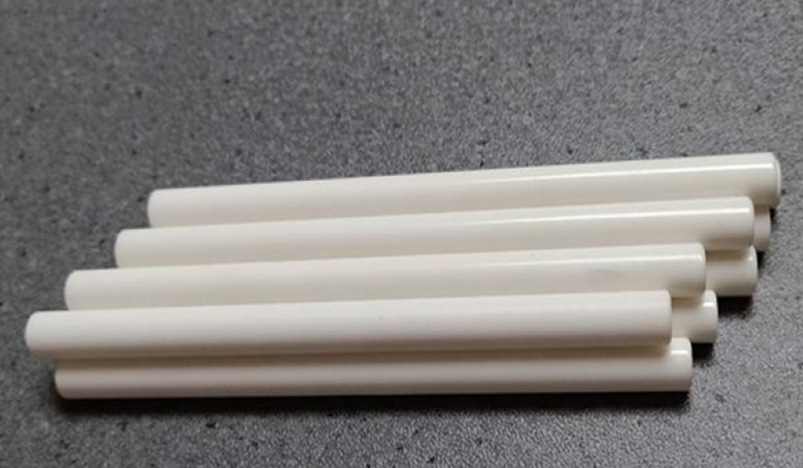
Boron Nitride vs Boron Carbide
Both boron carbide and boron nitride are non-oxide engineering ceramics, which are widely used in many industrial processes today, including high-temperature furnace fixtures and electronic systems.
This article explores most of the individual properties of boron carbide and boron nitride, as well as their industrial applications.
Boron Nitride
Boron nitride is a non-oxide engineering ceramic composed of boron and nitride, with a moderately low density compared to other non-oxide engineering ceramics. Boron nitride is a white crystalline solid material. It is resistant to heat and chemical attack and has refractory properties. The material exists in multiple polymorphs due to its platy hexagonal crystals. Boron nitride finds application in a wide range of industries.
Boron nitride is also known as “white graphite” because it is a lubricious material with similar platy hexagonal structure as carbon graphite. But unlike graphite, BN is a very good electrical insulator. It offers very high thermal conductivity and good thermal shock resistance. In inert and reducing atmospheres, boron nitride is stable for up to 2000°C, while in oxidizing atmospheres, it is stable for up to 850°C.
Three grades of this material are in common use. These include a boric oxide binder system, a pure diffusion bonded, and a calcium borate binder system grade. Each grade functions with different performance for different purposes. For instance, the boric oxide and calcium borate containing materials absorb are resistant to moisture, preventing swelling and property degradation. The pure boron oxide material which has no binders serves well in extreme temperature and where purity is important.
Boron Nitride Properties
1. Heat and chemical resistance: With a melting point of 2,973°C and a thermal expansion coefficient above that of diamond, it resists decomposition even at 1000°C and will not dissolve in common acids.
2. Thermal conductivity: boron nitride has a thermal conductivity comparable with that of graphene at 1700 to 2000 W/mK.
3. Lubrication: Boron nitride can boost the coefficient of friction of lubricating oil and reduce the potential for wear.
4. Density: the density of boron nitride ranges from 2.1 to 3.5 g/cm3, depending on the prevailing form.
Applications of Boron Nitride
As a Lubricant: The hexagonal form of boron nitride serves as a lubricant in paints, cement for dental applications, cosmetics, and pencil lead, and cement for dental applications. This is because boron nitride has significantly better chemical stability and electrical conductivity, even compared to graphite.
Equipment in high-heat environments: because of its exceptional resistance to heat, the compound is used in a wide variety of applications involving very high temperatures.
Semiconductor industry: the intrinsic thermal and dielectric properties of boron nitride make it suitable for developing metal-oxide-semiconductor field-effect transistors (MOSFETs) and semiconductors.
Abrasive and cutting implements: cubic boron nitride (one of BN polymorphs) can serve as an abrasive material for materials like iron, nickel, and other alloys, especially where diamond is not suitable (due to extreme heat).
Boron Carbide
Boron carbide is also a non-oxide engineering ceramic with moderately high heat capacity. Boron carbide is known for high-temperature stability and thermoelectric properties. It is a highly refractory material, which is important for both structural and electronic applications. The unique combination of properties of boron carbide makes it an ideal material for a wide range of engineering applications.
Due to its extreme abrasion resistance, it is used as abrasive powders and coatings; because of its hardness and low density, it is perfect for ballistic performance and is used as a neutron radiation absorbent in nuclear applications.
Properties of Boron Carbide
1. Boron carbide has a molar weight of 55.255 g/mol and a density of 2.52 g/cm3.
2. It has a melting point of approximately 2350 °C with a boiling point of 3500 °C
3. The hardness of the compound is up to 9.3 and the bending force is greater than 400 MPa. This property is central to a lot of boron carbide applications, including its usefulness in ballistic performances.
4. Boron carbide does not react with acidic or alkaline solutions. It's also resistant to high temperatures.
5. Boron carbide has a high cross-section of thermal neutron capture, as well as good anti-radiation properties and excellent neutron absorption power in nuclear reactors,
Applications of Boron Carbide
Boron Carbide is well suited for a wide variety of industrial applications due to its hardness, chemical inertness, and high neutron absorption cross-section.
- It is used as abrasives for lapping and ultrasonic cutting
- In nuclear reactors, boron carbide can be used as reactor control rods and neutron radiation absorbent.
- It serves as an antioxidant in carbon-bonded refractory mixes.
- Boron carbide is suitable for making cutting and grinding tools because of its hardness.
- Boron carbide nanoparticles are used in the manufacturing of tank armors. And because of their hardness and low density, they are also used in manufacturing bulletproof vests
- The nanoparticles of the compound are used in ceramic bearings to check wear and tear from; wire drawing dies and blasting nozzles due to their remarkable wear resistance.
.jpg)
Qatar Secures Place Among the World's Top 10 Wealthiest Nations
.jpg)
Hamad International Airport Witnesses Record Increase in Passenger Traffic

Saudi Arabia: Any visa holder can now perform Umrah

What are Qatar's Labour Laws on Annual Leave?
Leave a comment